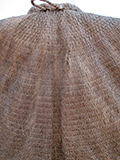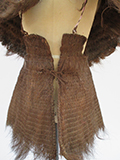The Japanese rainwear in NowesArk was created in Southern Japan in the first half of the twentieth century where the regional name is mino. It has a distinct and interesting appearance.
The mino is a hand-made garment, meant for a woman or a small man. It consists of two separate pieces, a cape and a skirt, that are tied together to make one functional outfit. The cape is wrapped around the neck and shoulders of the wearer and covers the entire back and most of the front, while the skirt covers the area from the ribs to about the knees. Both pieces are tied in the front to prevent them from sliding around. While the mino is made in two separate pieces, their overlapping nature and flared appearance creates a thatched-roof-like effect that allows the wearer complete mobility as well as protection from the rain. On the nape of the neck on the cape piece there is a loop that has been constructed as a part of the garment which is used to hang the mino to dry when it is not being worn. The skirt attaches to the cape with ties to keep the two pieces together made from the same fiber.
This mino is made entirely from fibers taken from coconuts and palm tree bark. Everything from the netting that makes up the foundation of the garment, and the thread that keeps it all tied together, to the thin cord that ties the cape and skirt both around the wearer and to each other comes from these fibers. The materials from which the mino is made are essential to its use because the palm fibers are durable enough for the mino’s every-day use, while maintaining waterproof properties that allow rain to funnel down and away from the wearer rather than soaking up the water and over time creating a wet, moldy coat. The basic construction of the mino has changed little over the years. They can be made to fit men, women, and children.
Processes for extracting the fibers from the materials used to make this mino are labor-intensive and time consuming. An important resource is The Conservation of Artifacts Made from Plant Materials by Mary-Lou E. Florian, who exhaustively documents the process. While this mino is Japanese, this style of construction was also common in China. Both the Textile Museum of Canada, the Auckland War Memorial Museum, and the University of Pennsylvania Museum of Archaeology and Anthropology hold examples of these forms, from China and Japan.
The first and arguably most obvious use can be found in its function as a rain coat, typically used by farmers and fishermen. They also have been used as camouflage. Scholars (and some twentieth-century war enthusiasts on the internet) have suggested that the mino would have likely been used during World War I by the Japanese to hide their soldiers among the natural flora of the battlefield.
© Zachary Cook, Class of 2016
Drama 475.001, Spring 2016 Semester
University of North Carolina at Chapel Hill




